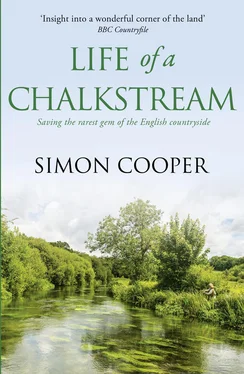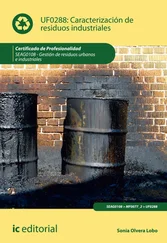You would think that the trout at Gavelwood would get used to me – after all, they must see me just about every day. But they never seem to. The only time they are oblivious to my presence is at spawning. Every other time they will bolt for cover if I disturb them. But at spawning I can stand on the bank almost directly above them and wave my arms about like a lunatic and they will carry on with their business. If I am in the river I can damn nearly step over them in my waders as they fin away one side or another to let me pass, to return to the same spot in my wake. The creation of the redd and the spawning to follow is all-consuming, but in their enthusiasm for each other the trout also forget about their most dangerous predator, the otter.
Otters are an ever-present but rarely glimpsed part of the Gavelwood family, about whom I have mixed feelings. On the one hand I should celebrate their existence, having come back in great numbers from the brink of extinction. But on the other they are one of the best fish-eating machines invented by Mother Nature. In ten months out of twelve it will be rare for me to see an otter, though most days I will be able to tell they have passed through. They are nocturnal creatures, using the river as their highway, travelling as much as 20 or 30 miles in a night. A paw print in a muddy bank, crushed grass where they slide into the river, and spraints, or dung, are all telltale signs, as is the corpse of a fish. In winter the latter will be barely recognizable as a fish: a few bits of fin, skin and scale in an area of flattened grass where the otter will have settled down to eat. If it is, or was, a gravid female trout there will be a scattering of eggs to add to the mix of body parts, which is sad in its own way, though they will rarely go to waste as the moorhens and water voles, or maybe a passing fox, are more than happy to feast on this unexpected bounty.
Every time I see the dog otter – I think we must have just the one – I am struck by his size and lithe movement. He is around twenty pounds in weight; put in context that is about twice the weight of a domestic cat. And like a cat he is incredibly supple; he doesn’t dive or jump into the river, he pours himself in, barely making a ripple. Once in the water, despite his bulk, he is hard to spot, but I’ll be able to track his underwater progress by the surge he creates on the surface. Some yards downstream he will pop his head out of the water, swivel around to check he has put sufficient distance between us and continue on his way at a more leisurely pace.
It is that bulk that makes the otter a deadly predator, because the bulk requires constant nutrition. It is reckoned that an adult male has to consume 10 per cent of his body weight each day to survive the winter. That is a two-pound fish, which is a big fish for the Evitt. More realistically we are talking about a whole bunch of smaller fish from trout, grayling and eels right down to the tiniest, like bullheads. Of course my otter’s diet is not pescatarian – frogs, crayfish, birds and water voles are all fair game – but in winter there are meagre pickings, so a careless spawning trout is a tempting prospect.
Come the summer things are very different; food abounds and so do the otters, which often become my evening companions when I stay late to fish the evening rise. I always hear them before I see them. Otters have this high-pitched ‘eek’ noise that they ping across the meadows like sonar to keep in touch with each other; it is the mother’s way of tracking the pups. As night falls the parents seem perfectly content to let the young ones range all over Gavelwood. I can become caught in this crossfire of constant eeking, and it is not a noise you have to strain to hear. It is incredibly insistent and frequent, though the frequency is a good indicator of how well things are going. I reckon that a contented otter eeks every thirty seconds; if one becomes distressed the frequency escalates until it becomes almost continuous. And it lasts all night or until the family move on to another part of the river.
These long, light summer nights are part of the growing-up phase for the pups, when the parents bring them out from the birthing holt to learn how to explore and hunt. Strangely, unlike most other species that become fiercely protective of their young, otters are more playful. They will often swim and hunt together in the river, just keeping a weather eye out for me. Otters are pretty well the top of the food chain and they regard humans as more of an oddity than a threat. However, lower down the chain the poor fish truly suffer.
Two fit adult otters, plus three or four ravenous, growing pups, seem to be the usual summer contingent that I will see in the twilight and on into the early hours of the morning. The solitary otter I see in the winter is a stealthy hunter, but in the summer the pack instinct takes over. Pike Pool, about halfway down the main river, is our deepest part of the Evitt and is the favourite place for the family to gather for a hunting lesson. The pool, which starts when the river makes an abrupt 90-degree turn, goes down to about 15 feet, constantly eroded by the water as it hits the opposite bank and swirls in back eddies before the gradient reasserts the natural order of things and the water heads downstream as it should. Along the bank stands a line of alder trees and the roots grow down into the water. Beneath the roots is a huge undercut, the perfect refuge for the fish and eels, or so they think.
The family will not so much hunt in a pack, but they do hunt collectively – rapidly diving and surfacing across the pool with their wet, brown fur glinting in the moonlight. They pause for just a moment to catch their breath before diving again. One can only imagine the massive panic in the fish community as they flee for safety in the dark recesses under the tree roots. And safe it is from every predator other than the otter. For herons and cormorants the fish are protected once out of sight. For mink they are too deep. Pike usually give up after a single attack. But otters are persistent. Once they have the fish cornered, they will dive and dive again. As the hunt becomes more frantic and the effort greater, they will emit a sharp cough when they surface to grab a breath. Inevitably they succeed and the victorious otters will slither out of the water onto the base of the tree to start devouring their catch. They sit back on their haunches, holding the fish in front of them using the sharp claws of their webbed feet for purchase, and then tear at the body, starting with the head. It is violent and fast. From the other side of the river I can hear the flesh being torn apart. Strangely they are not competitive about the catch; they wait their turn. When one has had enough he or she will lay what is left down for another to pick it up.
I have never yet seen the otters catch a salmon; maybe they are too big or simply swim away fast rather than hide. Trout are the most common, eels not far behind, and grayling the most prized – in winter they devour every last morsel of the latter. In the summer part-eaten fish or eels, too big for the otter pups to finish, are common. With the eels the head seems to be the only bit they like to eat; decapitated eels are a common sight in the morning dew. I usually kick them back into the river for the crayfish. I used to throw the part-eaten fish into the field – dead fish on the riverbed can look alarming to visitors – but since I have discovered that otters are partial to a five-day-old, decomposed trout I also kick them back in on the grounds that it might save the life of another fish.
It is something of a fallacy that trout love the fastest water in a section of a river to live out their lives; in fact almost the reverse is true. The older and bigger a trout becomes, the more he or she gravitates to the deeper, slower parts, so autumn is the only time we get to have a good look at the long-term residents who are the brood stock for the next generation. If you are a tiny little juvenile trout the fast, shallow water is a great place to grow up because you have the place to yourself. For the bigger trout the effort of holding station in the riffles, the fast-flowing shallow water that separates the pools, is too much for any possible rewards and the risk from predators like herons very high. But for the little, tiny trout even a good-sized pebble will provide shelter from the flow whilst waiting for a tasty nymph to come tumbling by. Predators? Well, when you are small it is all about the lesser of evils. Yes, you could be plucked from the stream by a kingfisher, but in truth your greatest danger lies from the very adult trout that probably spawned you. The one thing all fish love to eat is other fish.
Читать дальше












